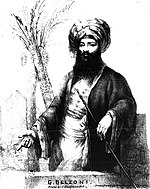Giovanni Battista Belzoni
| Giovanni Battista Belzoni | |
|---|---|

Giovanni Battista Belzoni
|
|
| Born |
5 November 1778 Padua, Republic of Venice |
| Died | 3 December 1823 (aged 45) Gwato, Benin Empire (now Ughoton, Edo State, Nigeria) |
| Nationality | Venetian |
| Known for | Egyptian antiquities |
| Spouse | Sarah Bane |
Giovanni Battista Belzoni (Italian pronunciation: [dʒoˈvanni batˈtista belˈtsoːni]; 5 November 1778 – 3 December 1823), sometimes known as The Great Belzoni, was a prolific Italian explorer and pioneer archaeologist of Egyptian antiquities. He is known for his removal to England of the seven ton bust of Ramesses II, the clearing of sand from the entrance of the great temple at Abu Simbel, the discovery and documentation of the tomb of Seti I (still sometimes known as "Belzoni's Tomb"), and the first to penetrate into the second pyramid of Giza.
Belzoni was born in Padua. His father was a barber who sired fourteen children. His family was from Rome and when Belzoni was 16 he went to work there, saying that he studied hydraulics. He intended taking monastic vows, but in 1798 the occupation of the city by French troops drove him from Rome and changed his proposed career. In 1800 he moved to the Netherlands where he earned a living as a barber.
In 1803 he fled to England to avoid being sent to jail. There he married an Englishwoman, Sarah Bane. Belzoni was a tall man at 6 feet 7 inches (2.01 m) tall (one source says that his wife was of equally generous build, but all other accounts of her describe her as being of normal build) and they both joined a travelling circus. They were for some time compelled to find subsistence by performing exhibitions of feats of strength and agility as a strongman at fairs and on the streets of London. In 1804 he appears engaged at the circus at Astley's amphitheatre at a variety of performances. Belzoni had an interest in phantasmagoria and experimented with the use of magic lanterns in his shows.
...
Wikipedia
